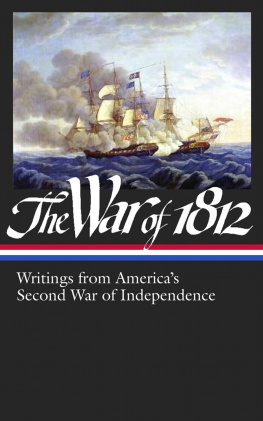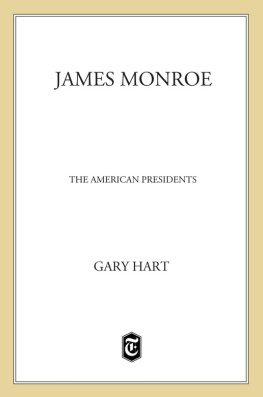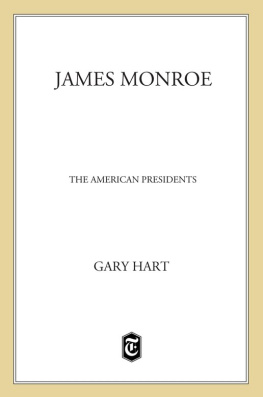F ire Along the Frontier is to some extent an outsiders view of the war, because there is an immense body of 1812 experts, from battlefield site programmers to professors to reenactor groups to private scholars, all intimately in tune with this war and its particular fascinations.
I have tried to take a somewhat different, at times radical, tack in my book, concentrating on the business of war, the campaigns and battles, and the lessons to be learned from them, and particularly why the Jeffersonians thought they could get away with armed robbery on an international scale against Britains crack regulars and thousand-ship navy.
I have tried to build on the scholarly foundations of War of 1812 experts like Donald Graves, Michael Gnarowski, Wesley Turner, Rene Chartrand, Robert Henderson and many others, including some reenactment groups and living history experts. And in the U.S., scholars like J. Langguth and Donald Hickey have done fine work, and I am in their debt.
Reading their works, I sometimes feel like an outsider peeking through a lace curtain into a regency drawing room, or a crack in the logs of a barracks wall. Reading them is sometimes like taking a trip in a time machine.
Any mistakes in this book are my own, but I have added a corrigendum on the support website, and astute or cranky readers can contact me there with criticisms, comments, and suggestions.
Above all I would like to thank the capable publishing people at Dundurn Press for adding this book to their 1812 oeuvre, of almost forty books on the war. From Kirk Howard and Beth Bruder, to Margaret Bryant and Shannon Whibbs, to my editor Allister Thompson, designer Jesse Hooper, and the editorial and marketing crew, thanks guys.
Attack on Sackets Harbor
Sir James Yeo Goes to Work
Late in 1812, the Admiralty knew it had to beef up defences on Lake Ontario to counter American action at Sackets Harbor. Sir George Prevost was complaining about the problems he faced in maintaining such a long line of communications. He asked for supplies and men from the Royal Navy to turn what was essentially a transport service the Provincial Marine of Upper Canada into a freshwater navy. With Napoleon reeling from his disastrous foray into Russia, the Admiralty felt comfortable enough in sending one of its top young officers, a dynamic thirty-year-old captain, Sir James Lucas Yeo, who had served on board His Majestys vessels since the age of eleven.
Yeo was used to unconventional sea warfare, so he was a good choice to replace Captain Earle in command on the Great Lakes. Yeo had captured privateers and pirate ships, stormed heavily fortified ports, and personally evacuated the Portuguese royal family to Brazil in the face of a French invasion of Portugal. In 1809, Yeo boldly captured Cayenne, French Guiana, expelling the last of Bonapartes forces from South America, for which action he was knighted.
Yeo received his commission on March 19 as commander-in-chief of the Lake Squadrons. He arrived at Quebec on May 5 with a large party of 437 naval officers, sailors, and shipwrights. They proceeded up the St. Lawrence toward Kingston. Past Montreal, they joined Sir George Prevost, who was also making his way to Kingston, to deal with replacing General Sheaffe, who had outraged some of the citizens of York by his overly rapid departure a month earlier.
Prevost and Yeo arrived at Kingston on May 15, and Yeo got to work with commanders Robert Heriot Barclay, Robert Finnis, and Daniel Pring, from Admiral Warrens naval establishment at Halifax. The first order of business was to complete a new sloop of war, the twenty-three-gun Wolfe and refit the twenty-two-gun Royal George , the sixteen-gun Prince Regent , the fourteen-gun brig Earl of Moira , two eight-gun schooners, and a number of gunboats in an effort to match or surpass Isaac Chaunceys flotilla at Sackets.
Yeos fleet was superior for the time being, but under-strength in men. His prime weapon was the thirty-two-pounder carronade, a marine mortar lethal in close combat but of limited range. Chaunceys twenty-four-gun Madison , sixteen-gun Oneida , and ten schooners were armed with long twenty-four-pounders, which gave them a big advantage at a distance. The Americans also had ample manpower, and were actively improving their wagon roads from the south to Lakes Erie and Ontario.

Sir James Lucas Yeo.
The Landing at Sackets Harbor
On May 25, only ten days after Yeos arrival, Prevost got a dispatch from General Vincent at Fort George, informing him that Chaunceys fleet was offshore supporting a major attack by the U.S. Army. Prevost knew he had a golden chance to relieve Vincent at Niagara, take Sackets Harbor, and with one blow win naval supremacy on the lake. But he had to scramble before Chaunceys return.
Two days later, Yeos instant squadron left Kingston carrying the grenadier company of the 100th Regiment, two companies of the 8th (The Kings) Regiment of Foot, four companies of the 104th Regiment, one company of the Glengarry Light Infantry, two companies of the Canadian Voltigeurs and a detachment of Royal Artillery with two six-pounder guns. Since no general officer was available to command the troops, Prevost took the job, while delegating command ashore to his adjutant general, Colonel Edward Baynes, an officer with minimal battlefield experience. If Granny Dearborn could command an expedition, why not himself?
Yeo and Prevost arrived off Sackets Harbor early the next morning. The wind had died down, making it dangerous to steer too close to the shore. Since he had no charts or soundings, and little lake experience, Yeo was properly cautious.
Just as Prevosts force started rowing ashore before midday, some sails were sighted in the distance. Nervous that the sails belonged to Chauncey, Prevost called off the attack and ordered the troops to go back to their ships. It was a false alarm. The sails belonged to twelve bateaux carrying U.S. infantry from Oswego to Sackets Harbor. The British sent out three large canoes of Iroquois warriors and a gunboat with a detachment of Glengarrys to intercept them. The Americans quickly headed for shore and fled into the woods, pursued by the Iroquois, who killed thirty-five soldiers. Their senior officer rowed out to Yeos fleet and surrendered his remaining force of 115 officers and men.
This episode gave the Americans plenty of advance warning. Under the command of Brigadier-General Jacob Brown of the New York state militia, with Lieutenant Woolcott Chauncey, younger brother of the commodore, their 400 regulars and 750 local militia worked feverishly to shore up their defences, which consisted of Fort Volunteer and Fort Tompkins, several strong blockhouses and a line of earthworks together. The hill to the fort also featured an abatis engineered from felled trees and branches by Alexander Macomb, one of the smartest generals in the U.S. Army, who was now in command of a unit at Fort George.
Prevost resumed the attack the following morning May 29, landing his troops south of the town on Horse Island, under fire from two six-pounder field guns and a naval thirty-two-pounder firing at long range from Fort Tompkins. Once the landing force was assembled, the British charged across the flooded causeway linking the island to the shore, chasing the fleeing militia. They then swung left to take the town and dockyard from the landward side, but the American regulars with some field guns held fast, and fell back behind their blockhouses and earthworks.
It was ticklish work, said Lieutenant John Le Couteur of the 104th Foot, who was armed only with an officers sword.







